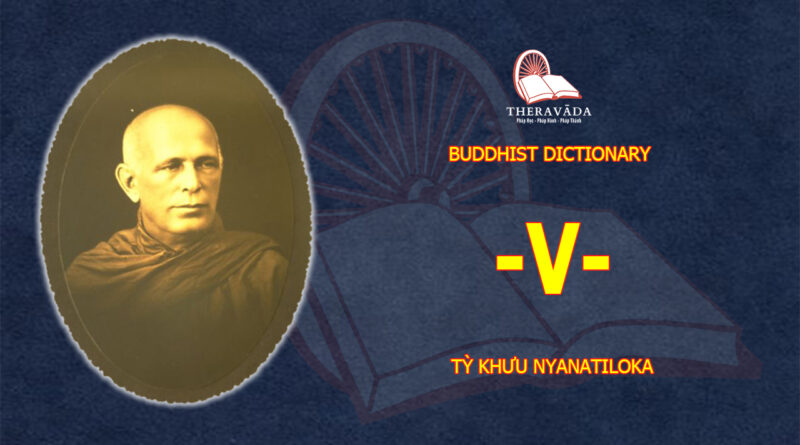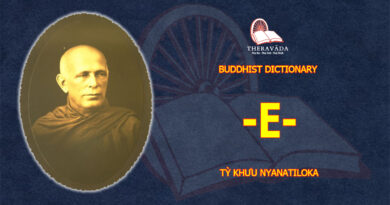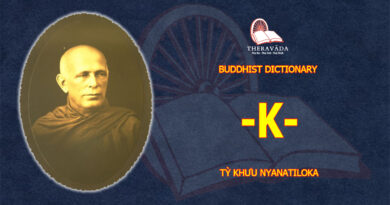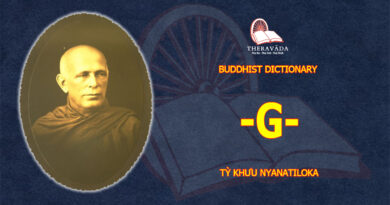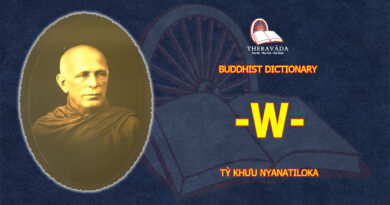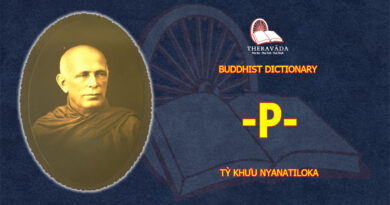BUDDHIST DICTIONARY
-V-
vācā: ‘speech’. On right sp., s. magga (3), sacca (IV.3). – Low talk, s. tiracchāna-kathā.
vacī-kamma: ‘verbal action’; s. kamma, kamma-kathā.
vacī-saṅkhāra: ‘verbal kamma-formation’, or ‘verbal function’.
(1) For verbal kamma-formation, s. saṅkhāra (I. 1).
(2) For verbal function (of mind), i.e. thought-conception and discursive thinking, s. saṅkhāra (I. 2).
vacī-viññatti: s. viññatti.
vanishing, Contemplation of: vayānupassanā, is one of the 18 chief kinds of insight (vipassāna, q.v.).
vanishing and reappearing: knowledge of the v. and r. of beings according to kamma, is identical with the divine eye (s. abhiññā 5).
vāritta-sīla: ‘morality consisting in avoiding’ (evil things), as distinguished from ‘morality consisting in performing’ (good things). See caritta–varitta.
vasī: ‘mastery’. Vis.M. IV speaks of 5 kinds of m., which anyone who wishes to develop the absorptions (jhāna, q.v.) should acquire first of all, with regard to the 1st absorption, namely: mastery in adverting to it (āvajjana–vasī), in entering it (samāpajjana–vasī), in determining it (adhiṭṭhāna–vasī), in rising therefrom (vutthāna–vasī), in retrospection (paccavekkhana–vasī). – (App.).
“If wherever, whenever, and for whatever duration desired, one enters the 1st absorption, and at one’s entering it, no slowness is experienced, this is called mastery in entering the absorption, etc. In an analogous way, the 4 remaining kinds are to be explained” (Vis.M. IV, 131f; XXIII, 27ff.).
vatta: 1. ’round’, 2. ’round of rebirths’.
(1) With reference to the dependent origination (paṭiccasamuppāda, q.v.), Vis.M. XVII speaks of 3 rounds: the kamma round (kamma-vatta) comprising the kamma-formations and the kammaprocess (2nd and 10th links); the round of defilements (kilesa–vatta) comprising ignorance, craving and clinging (1st, 8th and 9th links); the round of results (vipāka–vatta) comprising consciousness, mind and corporeality, 6 bases, impression, feeling (3rd-7th links). Cf. paṭiccasamuppāda (diagram).
(2) round of rebirth = saṃsāra (q.v.).
vatthu: ‘physical base’, i.e. the 6 physical organs on which the mental process is based, are the 5 physical sense-organs and, according to the Com., the heart (hadaya–vatthu, q.v.) as the 6th. This 6th vatthumust not be confounded with the 6th āyatana, which is a collective name for all consciousness whatever. – (App.).
vatthu-kāma: ‘objective sensuality’, the 5 sense-objects; s. kāma.
vavatthāna: ‘determining’, defining. In its application to insight meditation, this term occurred first in Pts.M. (I, p. 53); but in a verbal form, as a past participle, already in M. 111: tyassa dhammā anupada-vavatthitā honti, “these things (the mental factors) were determined by him (i.e. Sāriputta) successively” (s. Abh. St., p. 54). In Vis.M. XX, 130, it is said: ‘The determining of the truth of suffering is effected with the determining of mind-and-body in the purification of view (s. visuddhi III). The determining of the truth of origination is effected with the discerning of conditions in the purification by transcending doubt (s. visuddhi IV). The determining of the truth of the path is effected by emphasis on the right path in the purification by knowledge and vision of what is path and not-path (s. visuddhi V). Thus the determining of the 3 truths (suffering, origin, path) has been first effected by means of mundane (lokiya, q.v.) knowledge only.” – See sammasana, visuddhi.
For the determining of the 4 physical elements, s. dhātuvavatthāna.
vayānupassanā: ‘contemplation of vanishing’, is one of the 18 chief kinds of insight (vipassanā, q.v.).
vāyo-dhātu: ‘wind-element’; s. dhātu.
vāyo-kasiṇa ‘wind-kasiṇa’, is one of the kasiṇa exercises (kasiṇa, q.v.).
vedanā: ‘feeling’, sensation, is the 2nd of the 5 groups of existence (s. khandha II). According to its nature, it may be divided into 5 classes: (1) bodily agreeable feeling (kāyikā sukhā –vedanā = sukha); (2) bodily disagreeable feeling (kāyikā dukkhā–vedanā = dukkhā); (3) mentally agreeable feeling (cetasikā sukhā –vedanā = somanassa); (4) mentally disagreeable feeling (cetasikā dukkhā–vedanā = domanassa); (5) indifferent or neutral (adukkha-m-asukhā vedanā = upekkhā, q.v.).
With regard to the 6 senses, one distinguishes 6 kinds of feeling: feeling associated with seeing, hearing, smelling, tasting, bodily impression and mental impression. The textual wording of it is ‘feeling arisen through visual contact’ (cakkhu-samphassajā vedanā; S. XXII, 55; D. 22), etc.
Feeling is one of the 7 mental factors inseparably associated with all consciousness whatever, s. nāma. In the formula of the dependent origination (paṭiccasamuppāda, q.v.), feeling is the condition for the arising of craving (taṇhā). The above-mentioned 5 kinds of feeling are enumerated amongst the 22 faculties (indriya, q.v.). – See M. 59; Contemplation of Feeling (Vedanā Saṃyutta), by Nyanaponika Thera (WHEEL 303/304).
vedanānupassanā: ‘contemplation of feeling’, is one of the 4 foundations of mindfulness (Satipaṭṭhānaq.v.).
Vehapphala is the name of a class of heavenly beings in the fine-material world; s. deva.
verbal action: vacī-kamma; s. kamma.
verbal functions of mind: vacī-saṅkhāra; s. saṅkhāra.
vesārajja: ‘self-confidence’ of a Buddha is fourfold. He is confident: 1. to have attained to a perfect Enlightenment of which it cannot be said that it omits anything essential to it; 2. to have destroyed all cankers (āsava), leaving none that can be said to be undestroyed by him; 3. that what were declared by him as obstacles to liberation are undeniably such; 4. that his teaching fulfils its purpose of actually leading to final liberation from suffering. See A. IV, 8; VII, 58; M. 12.
vibhajja-vāda: ‘analytical or discriminating doctrine’ is an early name for the original Buddha doctrine, called Theravāda. – The term vibhajja–vādī occurs in M. 99 and A. X, 94, though not in the sense of a separate school, but as a characteristic of the Buddha himself: “Now, by blaming what is blamable and praising what is praiseworthy, the Blessed One is a ‘discriminating teacher’ (vibhajja–vādī ) and is not one-sided in his teaching” (A. X, 94).
Buddhaghosa, in the introduction to his Com. on the Kathāvatthu, says that in Asoka’s time, when the Saṃgha prospered, many heretics took ordination as Buddhist monks but continued to spread their wrong doctrines. For purifying the Saṃgha, Asoka, together with the venerable Moggaliputtatissa, summoned assembly of the bhikkhus. When each of the assembled was individually questioned by the king about what the Buddha taught, those who said that he was an eternalist (sassata-vadī), etc. were expelled. The genuine bhikkhus replied that the Buddha was a vibhajja–vadī, an ‘analyst’ or ‘discriminating teacher’; and when, on the king’s question, Moggaliputtatissa confirmed that this was the correct view, those monks were admitted to the Uposatha (q.v.) assembly of the Saṃgha, and from their midst the participants of the 3rd Council at Pataliputta were selected. – See Mahāvaṃsa, tr. by Wilh. Geiger, Ch. V, v. 268f.
vibhava diṭṭhi = uccheda-diṭṭhi; s. diṭṭhi.
vibhava-taṇhā: ‘craving for non-existence’, or for self-annihilation; s. taṇhā.
vicāra: ‘discursive thinking’; s. vitakka-vicāra.
vicikicchā : ‘sceptical doubt’, is one of the 5 mental hindrances (nīvaraṇa, q.v.) and one of the 3 fetters (saṃyojana, q.v.), which disappear for ever at Stream-entry, the first stage of holiness (s. ariya-puggala). As a fetter, it refers to sceptical doubt about the Master (the Buddha), the Teaching, the Saṃgha, and the training; about things past and future, and conditionality (Dhs. 1004; cf. A . X, 71 ) . It also applies to uncertainty whether things are wholesome or not, to be practised or not, of high or low value, etc. According to Vis.M. XIV, 177, vicikicchā is the lack of desire to think (things out i.e. to come to a conclusion; vigata–cikicchā, desiderative to √cit, to think); it has the nature of wavering, and its manifestation is indecision and a divided attitude; its proximate cause is unwise attention to matters of doubt. It is associated with one of the 2 classes of unwholesome consciousness rooted in delusion (Tab. I, No. 32). – See also kaṅkhā.
view, right: sammā-diṭṭhi; s. diṭṭhi, magga 1, sacca IV, 1. – For wrong view, s. diṭṭhi.
vigata-paccaya: ‘disappearance’, is one of the 24 conditions (paccaya, q.v.).
vihāra: ‘abode’ There are 3 abodes: the heavenly abode (dibba-vihāra), the divine abode (brahma-vihāra, q.v.), the noble abode (ariya–vihāra). See A. III, 63; D. 33.
vijjā: ‘(higher) knowledge’, gnosis. For the 3-fold k., s. abhiññā and te-vijjā. Cf. foll.
vijjā-caraṇa: knowledge and conduct’. This expression occurs in those passages in the Suttas where the qualities of a Buddha are described, namely: Truly, the Blessed One is holy, is fully enlightened, perfect in knowledge and conduct…” According to Vis.M. VII, 1 and D. 3, knowledge (vijjā) refers here either to the 3-fold knowledge (s. te-vijjā), or to the 8 kinds of knowledge, namely: the 6 higher spiritual powers (abhiññā, q.v.), insight (vipassanā, q.v.), and magical power (iddhi, q.v.); whilst conduct (caraṇa) refers to 15 things: moral restraint, watching over the sense-doors, moderation in eating, wakefulness, faith, moral shame, moral dread, great learning, energy, mindfulness, wisdom and the 4 absorptions.
vikkhambhana-pahāna: ‘overcoming by repression’ (or ‘suspension’), is one of the 5 kinds of overcoming (pahāna, q.v.).
vikubbanā-iddhi: the ‘power of transformation’, is one of the magical faculties (iddhi, q.v.).
vimamsā: ‘investigation, inquiry, pondering’, is one of the 4 roads to power (iddhi-pāda, q.v.) and one of the 4 factors of predominance (s. paccaya, 3).
vimokkha: ‘liberation’ (deliverance). I. the 3; II. the 8.
I. The 3 liberations are: 1. the conditionless (or signless) liberation (animitta -v.), 2. the desireless liberation (apanihita-v.), 3. the emptiness (or void) liberation (suññatā-v. ). They are also called ‘the triple gateway to liberation’ (vimokkha-mukha; Vis.M. XXI, 66ff), as they are three different approaches to the paths of holiness. – See visuddhi VI, 8. Cf. Vis XXI, 6ff, 121ff; Pts.M. II. Vimokkha-kathā.
1. “Whosoever being filled with determination (adhimokkha, q.v.), considers all formations as impermanent (anicca), such a one attains the conditionless liberation. 2. Whosoever being filled with tranquillity, considers all formations as painful (dukkha), such a one attains the desireless liberation. 3. Whosoever being filled with wisdom, considers all formations as without a self (anattā), such a one attains the emptiness liberation” (Vis.M. XXI, 70 = Pts.M. II, p. 58).
(1) and (2) are mentioned and explained in M. 43, under the name of deliverances of mind (ceto-vimutti, q.v.). – (2) and (3) appear in Dhs. (344ff, 353ff) in the section on supermundane consciousness (see Aṭṭhasālinī Tr., p. 299ff).
II. The 8 liberations (attha vimokkha) occur frequently in the texts (A. VIII, 66; D. 16, etc.) and are described as follows:
“There are 8 liberations, o monks. Which are these?
(1) ”Whilst remaining in the fine-material sphere (rūpī), one perceives corporeal forms: this is the first liberation.
(2) “Not perceiving corporcal forms on one’s own person, one perceives corporcal forms externally: this is the 2nd liberation.
(3) ”By thinking of the beautiful, one is filled with confidence: this is the 3rd liberation.
(4) “Through the total ovcrcoming of the corporeality-perceptions, the vanishing of the reflex-perceptions, and the non-attention to the multiformity-perceptions, with the idea ‘Unbounded is space’, one reaches the sphere of unbounded space (ākāsānañcāyatana) and abides therein: this is the 4th liberation.
(5) “Through the total ovcrcoming of the sphere of unbounded space, and with the idea ‘Unbounded is consciousness’, one reaches the sphere of unbounded consciousness (viññāṇañcāyatana) and abides therein: this is the 5th liberation.
(6) “Through the total overcoming of the sphere of unbounded consciousness, and with the idea ‘Nothing is there’, one reaches the sphere of nothingness (ākiñcaññāyatana) and abides therein: this is the 6th liberation.
(7) “Through the total overcoming of the sphere of nothingness, one reaches the sphere of neither-perception-nor-non-perception (n’eva-saññā-nāsaññāyatana) and abides therein: this is the 7th liberation .
(8) “Through the total overcoming of the sphere of neither-perception-nor-non-perception, one reaches the extinction of perception and feeling (s. nirodha-samāpatti): this is the 8th liberation.
These, o monks, are the 8 kinds of liberation.”
For (1-3), s. abhibhāyatana; for (4-7), s. jhāna; for (8), s. nirodha-samāpatti.
By (3) is meant the attainment of the fine-material absorptions (jhāna, q.v.) by means of concentrating the mind on perfectly pure and bright colours as objects of the kasiṇa (q.v.). According to Pts.M. this mental state is produced also by concentrating the mind on the 4 sublime states, i.e. all-embracing kindness, compassion, sympathetic joy and equanimity, in consequence of which allbeings appear perfectly pure and glorified, and thus the mind turns to the beautiful.
See Pts.M. II, Vimokkha-kathā; Aṭṭhasālinī Tr., p. 255; App.
vimutti: ‘deliverance’, is of 2 kinds: deliverance of mind (ceto-vimutti, q.v.) and deliverance through wisdom (paññā–vimutti, q.v.).
‘Deliverance of mind’, in the highest sense, is that kind of concentration (samādhi) which is bound up with the path of Arahatship (Arahatta-magga); ‘deliverance through wisdom’ is the knowledge (ñāṇa) bound up with the fruition of Arahatship (Arahatta-phala). Cf. A. V, 142.
There are also 5 kinds of deliverance, identical with the 5 kinds of overcoming (pahāna, q.v.).
vinipāta: ‘world of suffering’, is another name for the 4 woeful courses (duggati; s. gati) of existence, and for the 4 lower worlds (apāya, q.v.).
The Stream-Winner (Sotāpanna, q.v.) is no longer subject to rebirth in them (avinipāta–dhamma).
viññāṇa: ‘consciousness’, is one of the 5 groups of existence (aggregates; khandha, q.v.); one of the 4 nutriments (āhāra, q.v.); the 3rd link of the dependent origination (paṭiccasamuppāda, q.v.); the 5th in the sixfold division of elements (dhātu, q.v.).
Viewed as one of the 5 groups (khandha), it is inseparably linked with the 3 other mental groups (feeling, perception and formations) and furnishes the bare cognition of the object, while the other 3 contribute more specific functions. Its ethical and karmic character, and its greater or lesser degree of intensity and clarity, are chiefly determined by the mental formations associated with it.
Just like the other groups of existence, consciousness is a flux (viññāṇa-sotā, ‘stream of c.’) and does not constitute an abiding mind-substance; nor is it a transmigrating entity or soul. The 3 characteristies (s. ti-lakkhaṇa), impermanence, suffering and no-self, are frequently applied to it in the texts (e.g., in the Anattalakkhaṇa Sutta, S.XXII, 59). The Buddha often stressed that “apart from conditions, there is no arising of consciousness’ (M 38); and all these statements about its nature hold good for the entire range of consciousness, be it “past, future or presently arisen, gross or subtle, in oneself or external, inferior or lofty, far or near” (S. XXII, 59).
According to the 6 senses it divides into 6 kinds, viz. eye- (or visual) consciousness (cakkhu-v.), etc. About the dependent arising of these 6 kinds of consciousness, Vis.M. XV, 39 says: ‘Conditioned through the eye, the visible object, light and attention, eye-consciousness arises. Conditioned through the ear, the audible object, the ear-passage and attention, ear-consciousness arises. Conditioned, through the nose, the olfactive object, air and attention, nose-consciousness arises. Conditioned through the tongue, the gustative object, humidity and attention, tongue-consciousness arises. Condlitioned through the body, bodily impression, the earth-element and attention, body-consciousness arises. Conditioned through the subconscious mind (bhavaṅga–mano), the mind-object and attention, mind-consciousness arises.”
The Abhidhamma literature distinguishes 89 crasses of consciousness, being either kammically wholesome, unwholesome or neutral, and belonging either to the sense-sphere, the fine-material or the immaterial sphere, or to supermundane consciousness. See Table I.
viññāṇa-kicca: ‘functions of consciousness’, as exercised within a process of consciousness or cognitive series (cittavīthi). In the Abhidhamma Com. and Vis.M. XIV the following functions are mentioned: rebirth (paṭisandhi), subconsciousness (bhavaṅga), advertence (āvajjana), seeing, hearing, smelling, tasting, body-consciousness; recciving (sampaṭicchana), investigating (santīraṇa), determining (voṭṭhapana), impulsion (javana), registering (tadārammaṇa), dying (cuti).
A single unit of sense-perception (e.g. visual consciousness), being conditioned through a sense-organ and its corresponding object, forms in reality an extremely complex process, in which all the single phases of consciousness follow one upon another in rapid succession, while performing their respective functions, e.g.:
“As soon as a visible object has entered the range of vision, it acts on the sensitive eye-organ (cakkhu-pasāda), and conditioned thereby an excitation of the subconscious stream (bhavaṅga-sota) takes place.
“As soon, however, as subconsciousness is broken off, the functional mind-element (s. Tab. I, 70), grasping the object and breaking through the subconscious stream, performs the function of ‘adverting’ the mind towards the object (āvajjana).
“Immediately thereupon there arises at the eye-door, and based on the sensitive eye-organ, the eye-consciousness, while performing the function of ‘seeing’ (dassana)…. Immediately thereafter there arises the mind-element (Tab
I, 39, 55) performing the function of ‘receiving’ (sampaṭicchana) the object of that consciousness….
”Immediately thereafter there arises… the mind-consciousness-element (Tab. I, 40, 41, 56), while ‘investigating’ (santīraṇa) the object received by the mind-element…
“Immediately thereafter there arises the functional, rootless mind-consciousness-element (Tab. I, 71), accompanied by indifference, while performing the function of ‘determining’ (voṭṭhapana) the object……
“Now, if the object is large, then immediately afterwards there flash forth 6 or 7 ‘impulsive moments’ (javana-citta), constituted by one of the 8 wholesome, or 12 unwholesome, or 9 functional classes of consciousness (Tab. I, 1-8; 22-23; 72-80).
”Now, if at the end of the impulsive moments, the object at the five-sense doors is very large, and at the mind-door clear, then there arises, once or twice, one of the 8 root-accompanied, kamma-resultant classes of consciousness (Tab. I, 42-49) of the sense-sphere, or one of the 3 rootless kamma-resultant mind-consciousness-elements (Tab. I, 40, 41, 56)…. Because this consciousness after the vanishing of the impulsive moments, possesses the faculty continuing with the object of the subconsciousness, taking the object of the subconsciousness as its own object, therefore it is called ‘registering’ (tadārarmmaṇa, lit. ‘that object’, or ‘having that as object’)” (Vis.M. XIV, 115ff).
If, however, the sense-object is weak, then it reaches merely the stage of ‘impulsion’ (javana), or of ‘determining’ (voṭṭhapana); if very weak, only an excitation ot the subconsciousness takes place.
The proeess of the inner or mind-consciousness, i.e. without participation of the 5 physical senses, is as follows: in the case that the mind-objeet entering the mind-door is distinct, then it passes through the stages of ‘advertence at the mind-door’ (manodvārāvajjana), the ‘impulsive stage’ and the ‘registering stage’, before finally sinking into the subconscious stream. – (App.: citta-vīthi).
Literature: Aids to the Abhidhamma Philosophy, by Dr. C.B Dhammasena (with colour chart of the Cognitive Series; WHEEL 63/64). – The Psychology and Philosophy of Buddhism, by Dr. W. F. Javasuriya (Buddhist Missionary Socy., Kuala Lumpur, Malaysia).
viññāṇañcāyatana: ‘sphere of boundless consciousn is a name for the 2nd meditiative absorption in the immateria sphere (s. jhāna, 6).
viññāṇa-ṭṭhiti: ‘abodes or supports of consciousness’. The texts describe 7 such abodes (e.g. A. VII, 41):
(1) “There are beings who are different in body and different in perception, such as men, some heavenly beings, and some beings living in states of suffering (s. apāya). This is the 1st abode of consciousness.
(2) “There are beings who are different in body but equal in perception, such as the first-born gods of the Brahma-world (s. deva II). This is the 2nd abode of consciousness.
(3) “There are beings who are equal in body but different in perception, such as the Radiant Gods (ābhassara–deva). This is the 3rd abode of consciousness.
(4) ”There are beings who are equal in body and equal in perception, such as the All-illuminating Gods (subhakiṇha-deva). This is the 4th abode of consciousness.
(5) “There are beings … reborn in the sphere of boundless space. This is the 5th abode of consciousness.
(6) “There are beings … reborn in the sphere of boundless consciousness. This is the 6th abode of consciousness.
(7) There are beings… reborn in the sphere of nothingness. This is the 7th abode of consciousness”
About the 3 last-named spheres, s. jhāna (5-7). Cf. sattāvāsa.
In D. 33 there are mentioned 4 viññāṇa-ṭṭhiti, apparently in the sense of ‘bases’ of consciousness, namely: corporeality, feeling, perception, mental formations, which in S. XXII, 53 are further explained.
viññatti: (lit. ‘making known’) ‘intimation’, is an Abhidhamma term for bodily expression (kāya-viññatti) and verbal expression (vacī-viññatti), both belonging to the corporeality-group. They are produced by the co-nascent volition, and are therefore, as such, purely physical and not to be confounded with kamma (q.v.), which as such is something mental. Cf. Kath. 80, 100, 101, 103, 194 (s. Guide V). – (App.).
“One speaks of ‘bodily expression’, because it makes known an intention by means of bodily movement, and can itself be understood by the bodily movement which is said to be corporeal.
” ‘Verbal expression’ is so called because it makes known an intention by means of a speech-produced noise” (Vis.M. XIV).
vipañcitaññu: ‘one who realizes the truth after explanation.’ Thus is called one who realizes the truth only after detailed explanation of that which already had been said to him in a concise form. Cf. ugghaṭitaññu.
vipāka: ‘kamma-result’, is any kammically (morally) neutral mental phenomenon (e.g. bodily agreeable or painful feeling, sense-consciousness, etc. ), which is the result of wholesome or unwholesome volitional action (kamma, q.v.) through body, speech or mind, done either in this or some previous life. Totally wrong is the belief that, according to Buddhism, everything is the result of previous action. Never, for example, is any kammically wholesome or unwholesome volitional action the result of former action, being in reality itself kamma. On this subject s. titthāyatana, kamma, Tab. I; Fund II. Cf. A. III, 101; Kath. 162 (Guide, p. 80).
Kamma-produced (kammaja or kamma-samuṭṭhāna) corporeal things are never called kamma-vipāka, as this term may be applied only to mental phenomena.
vipāka-paccaya: ‘kamma-result condition’ is one of the 24 conditions (paccaya, q.v.).
vipallāsa: ‘perversions’ or ‘distortions’. – ”There are 4 perversions which may be either of perception (saññā–vipallāsa), of consciousness (citta v.) or of views (diṭṭhi-v.). And which are these four? To regard what is impermanent (anicca) as permanent; what is painful (dukkha) as pleasant (or happiness-yielding); what is without a self (anattā) as a self; what is impure (ugly: asubha) as pure or beautiful” (A. IV, 49). – See Manual of Insight, by Ledi Sayadaw (WHEEL 31/32). p.5.
“Of the perversions, the following are eliminated by the 1st path-knowledge (Sotāpatti): the perversions of perception, consciousness and views, that the impermanent is permanent and what is not a self is a self; further, the perversion of views that the painful is pleasant, and the impure is pure. By the 3rd path-knowledge (Anāgāmitā) are eliminated: the perversions of perception and consciousness that the impure is pure. By the 4th path-knowledge (Arahatta) are eliminated the perversions of perception and consciousness that the painful is pleasant” (Vis.M. XXII, 68).
vipariṇāmānupassanā: ‘contemplation of change’ (of all things), is one of the 18 chief kinds of insight (vipassanā, q.v.).
vipassanā: ‘insight’, is the intuitive light flashing forth and exposing the truth of the impermanency, the suffering and the impersonal and unsubstantial nature of all corporeal and mental phenomena of existence. It is insight-wisdom (vipassanā-paññā) that is the decisive liberating factor in Buddhism, though it has to be developed along with the 2 other trainings in morality and concentration. The culmination of insight practice (s. visuddhi VI) leads directly to the stages of holiness (s. visuddhi VII).
Insight is not the result of a mere intellectual understanding, but is won through direct meditative observation of one’s own bodily and mental processes. In the commentaries and the Vis.M., the sequene in developing insight-meditation is given as follows: 1. discernment of the corporeal (rūpa), 2. of the mental (nāma), 3. contemplation of both (nāmarūpa; i.e. of their pairwise occurrence in actual events, and their interdependence), 4. both viewed as conditioned (application of the dependent origination, paṭiccasamuppāda), 5. application of the 3 characteristics (impermanency, etc.) to mind-and-body-cum-conditions.
The stages of gradually growing insight are described in the 9insight- knowledges (vipassanā-ñāṇa), constituting the 6th stage of purification: beginning with the ‘knowledge of rise and fall’ and ending with the ‘adaptation to Truth’. For details, see visuddhi VI and Vis.M. XXI.
Eighteen chief kinds of insight-knowledge (or principal insights, mahā-vipassanā) are listed and described in Vis.M. XXII, 113: (1) contemplation of impermanence (aniccānupassanā), (2) of suffering (dukkhānupassanā), (3) of no self (anattānupnupassanā), (4) of aversion (nibbidānupassanā). (5) of detachment (virāgānupassanā), (6) of extinction (nirodhānupassanā), (7) of abandoning (paṭinissaggānupassanāā), (8) of waning (khayānupassanā), (9) of vanishing (vayānupassanā), (10) of change (vipariṇāmānupassanā), (11) of the unconditioned (or signless, animittānupassanā), (12) of desirelessness (apaṇihitānupassanā), (13) of emptiness (suññatāupassanā), (14) insight into phenomena which is higher wisdom (adhipaññā–dhamma-vipassanā), (15) knowledge and vision according to reality (yathā-bhūta-ñāṇadassana), (16) contemplation of misery (or danger, ādīnavānupassanā), (17) reflecting contemplation (paṭisaṅkhānupassanā), (18) contemplation of turning away (vivaṭṭanānupassanā).
Through these 18, the adverse ideas and views are overcome, for which reason this way of overcoming is called ‘overcoming by the opposite’ (tadaṅga-pahāna, overcoming this factor by that). Thus (1) dispels the idea of permanence. (2) the idea of happiness, (3) the idea of self, (4) lust, (5) greed, (6) origination, (7) grasping, (8) the idea of compactness, (9) kamma-accumulation, (10) the idea of lastingness, (11) the conditions, (12) delight, (13) adherence, (14) grasping and adherence to the idea of substance, (15) attachment and adherence, (17) thoughtlessness, (18) dispels entanglement and clinging.
Insight may be either mundane (lokiya, q.v.) or supermundane (lokuttara, q.v.). Supermundane insight is of 3 kinds: (1) joined with one of the 4 supermundane paths, (2) joined with one of the fruitions of these paths, (3) regarding the extinction, or rather suspension, of consciousness (s. nirodha-samāpatti).
See samatha-vipassanā, visuddhi, III-VII.
Literature: Manual of Insight, by Ledi Sayadaw (WHEL 31/32). Practical Insight Meditation, Progress of Insight, both by Mahāsi Sayadaw (BPS). The Experience of Insight, by Joseph Goldstein (BPS).

